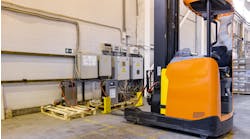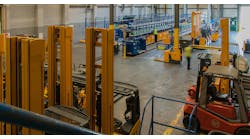Can Segway Segue Into Warehousing?
Heads up, lift truck vendors. With much fanfare, secrecy leaks and market hype, a new kid has been introduced to the world, and “IT” is threatening to revolutionize movement in the warehouse along with other forms of surface travel, like the car.
IT, now known as the Segway Human Transporter, is a two-wheeled, one-person, battery-powered device that looks a lot like a scooter. Before pointing out a few problems, let me acknowledge first that it is a fantastic engineering feat. With no brakes, no engine, no throttle, no gearshift and no steering wheel, it cannot lose its balance. That’s a marvelous design. And I’m sure it will be useful ... somewhere.
But I have my doubts about whether it will change how we use cars, let alone transform business applications like warehousing.
The marketing approach is two-pronged. The consumer market is where the money is, but the business market is where the first paying customers will likely come.
For consumers, the idea is that people will buy one or more of these devices, stick them in their car trunks, drive close to the city and park their cars. From there, they will remove one or more (depending on the number of passengers), and scoot to their offices or to lunch, to do a little shopping or head to the theater. That’s the inventor’s idea. I have a slightly different take. At $3,000 a pop, I don’t see the advantage in cutting my walking time to the office by seven minutes. Plus, I live in a city that gets snow or rain much of the year. I did not see any weather protection on the scooter, making it a summer-use-only device. Now, if they cut the price to about $300, I might consider it.
Given this information, can Segway be useful in business applications, such as material handling? Well, the U.S. Postal Service seems to think so, and will test 20 models on routes where mail carriers apparently still walk to make deliveries. And Amazon.com plans to try these gizmos out in its warehouses. By the way, for industrial users, the price is about $8,000 a piece.
With a top speed of about 12 miles per hour, you can just stand on it and it moves up and down your warehouse aisles for a total of 17 miles on one battery charge. Great. So you can zip around the warehouse floor in a matter of minutes. This capability had better be useful for more than faster delivery of printed pick lists, however. Most warehouse applications involve grasping items and putting them some place. Imagine operators standing on their scooters, while the scooters are moving, with their arms full of various sized boxes. Oops, someone dropped a box.
There’s something missing from this picture, like secure carrying capacity.
What all the news shows didn’t mention is that bags can be added to this scooter-like device. According to the specifications, it will handle a cargo of 75 pounds. There are future plans for an off-board cargo module that will hold 300 pounds. Now we’re starting to get a bit more useful, especially in today’s new world of shipping single, small items. But I doubt if lift truck vendors have broken into a sweat yet.
For one thing, there’s the battery. According to one report, it takes about six hours to charge the device. And the battery needs recharging after 17 miles of travel. Lift trucks tend to go longer and farther.
I won’t say that Segway won’t be a success. Lots of people thought that about the Internet, the personal computer and other technologies. And there’s no doubt it’s fun to ride. The question not answered though is: Is it a good business solution? It will be interesting to see what the post office and Amazon.com discover.


